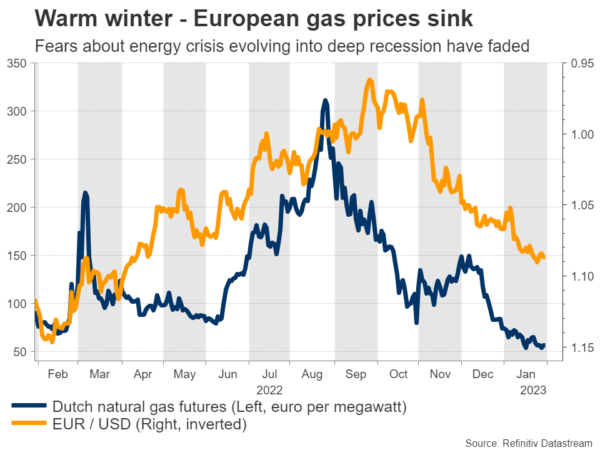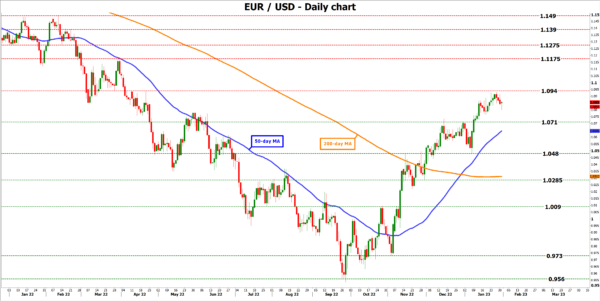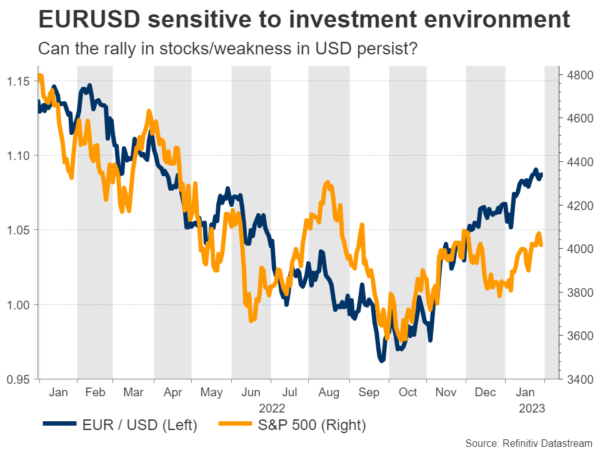The European Central Bank will announce its next policy decision at 13:15 GMT on Thursday. A rate increase of 50bps is already fully priced in, so the euro’s reaction will depend mostly on President Lagarde’s commentary. The economic outlook has improved lately and inflation remains elevated, so a hawkish message that lifts the euro a little might be in store. That said, the bigger picture isn’t so bright.
Rescued by the weather
The Eurozone economy has been surprisingly resilient in recent months. Thanks to a historically warm winter, fears about the energy crisis evolving into a harsh recession have calmed down. Natural gas prices are back to pre-war levels, brightening the outlook around economic activity.
Of course, the region is not out of the woods. Business surveys paint a picture of an economy that is essentially stagnating. It might not be a recession, but the persistent decline in new business orders coupled with the relentless increase in borrowing costs paints a gloomy picture about economic growth moving forward.
Inflation is still raging, forcing the European Central Bank to keep its foot heavy on the rate increase pedal. The next update on inflation will come on Wednesday, ahead of the ECB decision on Thursday. Even though forecasts suggest the CPI rate declined to 9% in January from 9.2% previously, that is still an unacceptably high level for the central bank.
In fact, there’s a risk of an upside surprise in this inflation report, as surveys showed that businesses raised their selling prices at a slightly faster pace in January, something also reflected in regional numbers for France and Spain that have already been released.
A hawkish twist?
Back in December, President Lagarde stressed the need to move quickly on rates, effectively pre-committing to a 50bps rate increase at this upcoming meeting. Accordingly, markets have fully priced in the rate hike, putting the spotlight mostly on what Lagarde will say during her press conference.
A case can be made that she might strike a hawkish tone. The economic outlook is improving ever so slightly, with GDP growth for Q4 turning positive and China’s economic reopening bolstering confidence. Meanwhile, the recent loosening in financial conditions will be worrisome for ECB officials, as it could prevent inflation from returning to its target in a reasonable timeframe, making them likely to push back.
The question for markets is whether Lagarde will telegraph another 50bps move for March, which seems likely considering everything above. If that’s the case, the euro could spike higher, with the first major obstacle for euro/dollar likely to be the recent high near 1.0940.
Euro prospects not so bright
Overall, the euro staged a phenomenal rally in recent months. Much of that was due to favorable weather patterns that helped reduce energy prices and recession risks, but China’s reopening, soaring stock markets, and a softer US dollar also played a big role.
Admittedly, it’s difficult to envision this rally lasting much longer. Even if a recession is avoided, the best-case scenario in Europe is economic stagnation, since there isn’t much to drive growth forward. Higher interest rates will come back to bite eventually, especially economies with high debt burdens such as Italy.
The weakness in the dollar and the euphoria in stocks were instrumental pieces behind the euro’s resurgence, but those were caused partly by a liquidity dump from the US Treasury, which might reverse soon. On a simpler level, a global environment characterized by heightened recession risks favors a softer euro/dollar.
In other words, the risk/reward profile for the euro doesn’t seem attractive anymore in this investment environment. Technically speaking, any retreats in euro/dollar could encounter initial support around the 1.0710 region.















